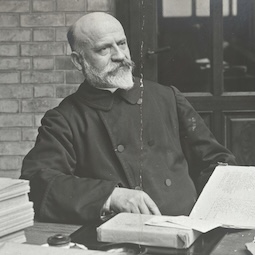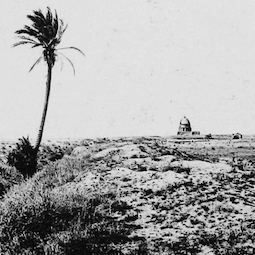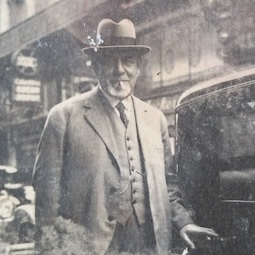Local excavations and antiquities dealers (1909-1911)
Outside Iraq, museums not only hold archaeological artefacts from Kish received from excavation work they supported, they also own thousands of objects which they purchased from antiquities dealers in the 20th century. This is visible in the correspondence exchanged between curators and dealers based in Baghdad, Paris, London, and New York. These documents, preserved in museum archives as part of their collections' history, show that archaeological work led by local residents was ongoing at Kish long before foreign-led excavations began work on site in the 20th century. This fact was well-known among Assyriologists who studied this newly acquired material at the time.
 [/kish/images/pere-scheil-large.jpg]
[/kish/images/pere-scheil-large.jpg]Figure 1: Father Jean-Vincent Scheil (unknown photographer, undated). Source: Bibliothèque de la Sorbonne, CC BY-SA 4.0 [https://en.wikipedia.org/wiki/Jean-Vincent_Scheil#/media/File:Cours_de_M._le_professeur_Scheil_(Assyriologie),_la_Sorbonne,_%C3%89cole_des_hautes_%C3%A9tudes.jpg]
For example, Father Jean-Vincent Scheil (1858-1931) (Figure 1) referenced "recent clandestine excavation missions" in his address to the Académie des inscriptions et belles-lettres in 1911 (Scheil 1911: 611).[1] Henri de Genouillac, in his report about his excavations at Kish in 1912, writes that it was the work conducted locally for "close to 10 years" which had decided him to choose this site to excavate (Genouillac 1924–25: I 10).[2] He speaks about the trenches he observed on arrival, which showed the site had been well explored by then,[3] and the Imam Said mausoleum (Figure 2), where workers would find refuge at night given its close proximity to the site (Genouillac 1924–25: I: 15, 17).[4]
 [/kish/images/imam-said-shrine-1912-large.png]
[/kish/images/imam-said-shrine-1912-large.png]Figure 2: The Imam Said mausoleum near Kish, in early 1912. Source: Genouillac, PRAK I, pl. XXII/1.
Among the many antiquities dealers who approached the British Museum, Ibrahim Elias Gejou (1868-1942) (Figure 3) discussed artefacts from Kish, specifically Tell al-Uhaimir, in 1909. In a letter dated 24 November addressed to Wallis Budge (1857-1934), Keeper of the Egyptian and Assyrian Antiquities Department, Gejou speaks of 124 cuneiform tablets he had just received from "Hummer", a "new site".[5] So that Budge could examine and value them, Gejou explained he would be sending four tablets as samples. In this letter, Gejou places this new site "north of Abu-Haba" (Sippar), no doubt a slip as Kish is south of Sippar, and a recent study of these texts has now confirmed they originate from Kish (Reid and Wagensonner 2025). After this offer, Gejou sent Budge eight other cuneiform tablets from the "new discovery made near Nippur" in March 1910,[6] and also advised him later in that year that he had another collection for sale, one made of about 700 to 800 tablets from two different locations, "Ahemir" (Tell al-Uhaimir), and "Abu Haba" (Sippar).[7]
This locally-led work seems to have continued in 1911, as illustrated by Gejou's subsequent offers. Writing in February 1911 to his main client in the USA, Albert T. Clay (1866-1925), curator of the Yale Babylonian Collection, Gejou discusses his shipping of 5200 cuneiform tablets discovered at six different sites: Birz Nimrod (Borsippa), Babylon, Abu Habba (Sippar), Drehem (Puzrish-Dagan), Geokha (Umma), and "Ahemir" (Kish).[8] This enormous collection, for which he wanted £2500,[9] was shipped to the US in six cases via "American Express". Four months later, Gejou would write to Clay again, asking if the latter was interested in mathematical tablets from Kish ("Ahimer"). He had just received them from Iraq.
The names of the local residents who conducted these excavations have not survived in Assyriological studies, nor have the reasons which led them to dig at Tell al-Uhaimir. But their work not only brought new information to scientific communities across the world, it also inspired foreign scholars to explore to the site themselves, as both Scheil and de Genouillac acknowledged.
Notes
- "La deuxième dynastie est dite de Kish. Cette ville est actuellement la ruine d'Oheimir, à 20 kilometres sud-est de Babylone, comme l'ont indiqué les premiers assyriologues et comme les fouilles récentes clandestines des Arabes viennent le confirmer." [Return to main text]
- "L'intérêt du site était affirmé par de nombreux textes provenant de fouilles clandestines pratiquées par les Arabes depius près de dix ans [...] Une autre pensée qui m'avait déterminé à choisir El-Akhymer était l'espoir de retrouver la trace de quelques-uns des plus illustres rois d'Accad". [Return to main text]
- "Les fouilleurs indigènes ont largement exploité cette region et en ont litteralement criblé le sol de trous et de galeries, c'est de ces sondages faits sans ordre que proviennent tous les textes qui nous sont parvenus d'El-Akhymer avant 1912." [Return to main text]
- "Un quart d'heure avant d'arriver nous passâmes près du turbe ou tombeau de l'imam Said c'est là que les arabes qui travaillaient depuis dix ans à El-'Akhymer se refugiaient la nuit". [Return to main text]
- Gejou's letter to Wallis Budge, 24 November 1909: "Par le S/S Edenhall j'ai reçu une collection de 124 tablettes de Hum-mer, un nouvel endroit qui est au nord d'Abu Haba". In Correspondence Volumes of the Egyptian and Assyrian Antiquities Department, British Museum Central Archive. [Return to main text]
- Gejou's letter to Wallis Budge, 16 March 1910: "il y a également beaucoup de tablettes de la nouvelle trouvaille faite près de Nippour [sic] dont je vous envoie en postal 8 specimens", in Correspondence Volumes of the Egyptian and Assyrian Antiquities department, British Museum Central Archive. [Return to main text]
- Gejou's letter to Wallis Budge, 14 December 1910: "J'ai une affaire de 7 à 800 tablettes de Ahemir [kish] & Abu Haba, la plupart nettoyée – voyez vous la possibilité de me les acheter ?", in Correspondence Volumes of the Egyptian and Assyrian Antiquities Department, British Museum Central Archive. [Return to main text]
- List of objects sent by Gejou to Clay dated 16 February 1911: "Expédition faite par l'entremise de American Express Company en 6 caisses à son adresse & contenant : 1) 1 Collection de 5200 tablettes Babyl : provenant des fouilles de Birz Nimrod, de Babel, d'Abu Haba, de Ahémir, de Dreham & de Geokha ensemble pour £2500". [Return to main text]
- £2500 in 1911 represents circa £376,322 in 2025, or $486,497.55, see CPI Inflation Calculator [https://www.in2013dollars.com/uk-inflation/]. [Return to main text]
30 Jun 2025
Nadia Aït Saïd-Ghanem
Nadia Aït Saïd-Ghanem, 'Local excavations and antiquities dealers (1909-1911) ', The Forgotten City of Kish • مدينة كيش المنسية, The Kish Project, 2025 [http://oracc.org/ModernhistoryofKish/Dealers1909-1911/]
